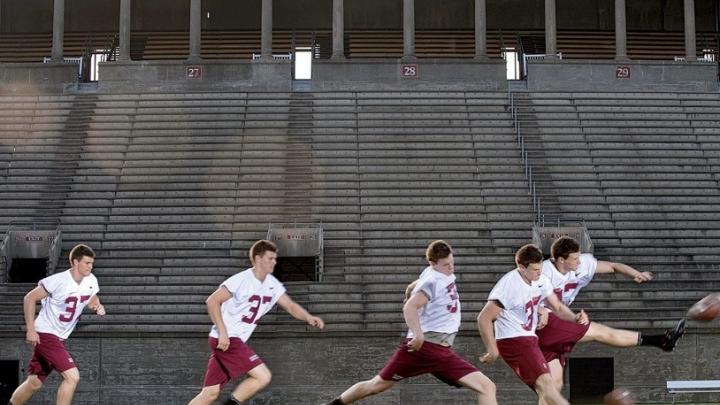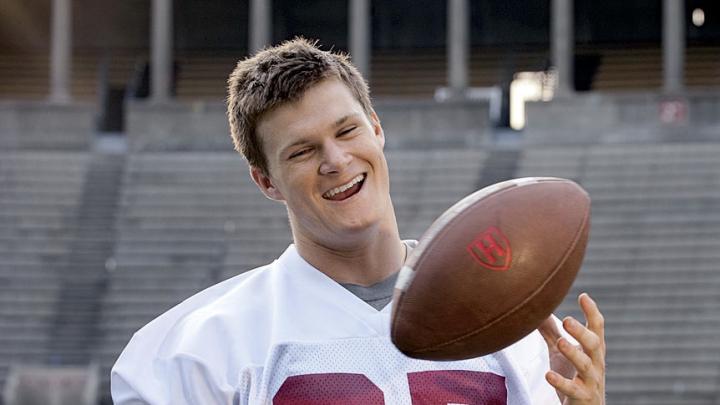The play that shone the brightest spotlight on David Mothander ’14 hardly typifies what he does on a football field. Last November, with Harvard leading Yale, 14-7, in the second quarter, the Crimson and their placekicker, Mothander, lined up for a 22-yard field-goal attempt from the Yale 12. Instead, with a perfectly executed fake, holder Colton Chapple ’13 flipped the ball to Mothander, who sprinted unopposed into the end zone. Touchdown, Harvard.
Mothander (MOE-tander) is very comfortable with the football in his hands: he played quarterback at St. Margaret’s Episcopal School in San Juan Capistrano, California. Quarterbacks are often the best all-around athletes on their high-school teams, and many play other positions on college varsities. “I think there were eight high-school quarterbacks in [my Harvard] class alone,” he says.
At six feet, three inches, Mothander’s a bit taller than most placekickers, and his experience as a goalie in high-school soccer (he also lettered in baseball as a pitcher and shortstop) may have taught him how to put leg into the ball. Goalkeepers take plenty of goal kicks—the object, naturally, being to send the ball as far as possible from the goal and out of the opponents’ reach—to hit it “long and high,” as Mothander says. Very similar, in other words, to a kickoff.
Those who watch the National Football League get used to seeing placekickers convert 80 percent or more of their field-goal attempts despite hitting balls spotted 40-plus and even 50-plus yards from the goalposts. Placekicking in the college game is a considerably less routine matter, but Mothander has been a solid performer. Last season, he converted six of eight attempts and hit a long one of 42 yards. He also aced 48 of 50 extra points. As a freshman (he arrived at Harvard after a postgraduate year at Phillips Exeter Academy), he made nine of 15 field goals (including one of 43 yards) and 34 of 35 extra points. He also sent 50 kickoffs downfield for an average of 63.1 yards, and achieved comparable results last season.
New NCAA rules will make kickoffs more effective this year, as kicking teams tee up the ball on the 35-yard line instead of the 30, making kicks effectively five yards longer. In addition, touchbacks will now come out to the 25-yard line instead of the 20, offering returners five yards more incentive to forgo a runback. The changes aim to scale down kickoff returns, which rank among the most exciting but also the most dangerous plays in the game, due to high-speed collisions, frequent instances of clipping (blocking from behind), and the semi-chaotic nature of the play itself.
None of this will affect Mothander’s technique, which he began learning before his last year at St. Margaret’s and improved at summer kicking camps. For kickoffs, he uses a nine-step approach (five left, four right), beginning nine yards behind the ball and about five yards to the left, to set up “a more natural motion,” he says. “You want a consistent approach—be consistent with your plant foot, your strike foot, and hit the ball at the same spot with the same part of your foot.” Kickers aim to contact the ball about one-third of the way up from the ground, and just past the bottom of their leg swing’s semicircular arc.
On kickoffs, the kicker can start the run-up from anywhere he chooses—theoretically, he could start sprinting at the goal line and hit the ball 35 yards later. Field goals are a different animal: they’re essentially a three-man play that includes a long snapper (making a seven-yard snap), a holder, and the kicker. (Harvard’s long snapper is Tyler Ott ’14; quarterback Chapple has held the ball for Mothander since the kicker’s arrival.)
The second crucial difference is that the defense rushes from the line of scrimmage, attempting to block the kick. Field-goal kicks need to rise more steeply than kickoffs, in order to clear the line. Mothander uses a four-step approach (left-right-left-right), starting two steps to the left of the ball, and aims to get the kick off 1.25 to 1.30 seconds after the snap. “It’s quick enough to make it difficult to block the kick,” he says, “and long enough to have enough time to hit a solid ball. The mindset that you have to have is that every kick is an extra point, because being smooth through the ball is the best way to hit an accurate ball.” Crosswinds means factoring in the sideways drift, and against a headwind, he explains, “The longer the kick is, the more the wind will affect it, because the ball slows down more as it approaches the goalposts.”
Accuracy involves maximizing the surface area of the foot in contact with the ball, and the duration of contact. The more “foot” a kicker can apply to the pigskin, the more control he’ll have over where that ball goes. That’s done by kicking the ball “soccer style,” the technique that has become nearly universal since the 1960s. Soccer-style kicking, which strikes the ball with the instep, greatly increases accuracy by putting much more foot surface on the ball than the toe-punch technique it supplanted. (The toe-punch does generate power, but is hard to control.)
With field goals and extra points, placekickers often lead their teams in scoring. The job involves pressure, but probably less roughhouse than any other position. On rare occasions, if a returner gets loose for a long runback, the kicker may be the last man able to tackle him. “With any luck,” says Mothander, with a grin, “it doesn’t come to that.”









